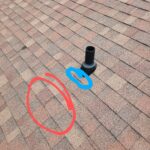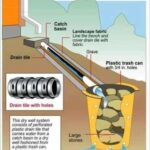Are you tired of dealing with that pesky drip-drip-drip sound that seems to echo through your home every time it rains? A roof leaking around a vent pipe is more than just an annoyance—it can lead to serious damage if left unchecked.
You might feel overwhelmed, wondering how something as small as a vent pipe could cause such a big problem. But don’t worry! We’re going to unravel the mystery behind these leaks and show you exactly what you can do to fix them.
Imagine turning your rainy days from stress-filled moments into ones of cozy relaxation, knowing your home is safe and dry. Ready to put an end to your roof worries? Keep reading to discover the solutions that will protect your home and give you peace of mind.

Credit: mydividedsky.com
Common Causes Of Roof Leaks Around Vent Pipes
Roof leaks around vent pipes can be a frustrating problem for homeowners. These leaks often start small but can lead to significant damage if ignored. Understanding the common causes of these leaks can help you take preventive measures and maintain the integrity of your roof.
Damaged Flashing
Flashing is the material used to seal the area where the vent pipe meets the roof. It acts as a barrier to prevent water from seeping through. However, over time, flashing can become damaged due to weather conditions or physical wear and tear. If you notice water stains around your vent pipe, it might be time to inspect the flashing. Replacing damaged flashing is a straightforward task that can save you from costly repairs down the road.
Cracked Rubber Boot
The rubber boot is a flexible piece that fits tightly around the vent pipe to keep water out. As rubber ages, it can crack or deteriorate, allowing water to penetrate your roof. If you’ve noticed a leak during a rainstorm, check the condition of the rubber boot. A simple replacement can often solve the issue and prevent further water damage.
Improper Installation
Sometimes, the problem isn’t wear and tear but rather how the vent pipe was installed initially. Poor installation can leave gaps or misalignments that lead to leaks. If your roof is relatively new yet leaking, improper installation might be the culprit. Have you ensured your roof was installed by a trusted professional? Regular inspections can identify installation errors early and keep your home dry.
Addressing these issues promptly can protect your home from water damage. Regular maintenance and inspections are key. Have you checked your roof lately?
Signs Of A Leak Around Vent Pipes
Vent pipes are crucial for maintaining proper airflow in your plumbing system, but they can also be sneaky culprits of roof leaks. Identifying the signs of a leak around vent pipes early can save you from costly repairs and prevent further damage. If you’ve noticed something amiss in your home, it’s time to investigate these telltale signs. Let’s dive into the specifics.
Water Stains On Ceiling
Have you ever looked up and noticed a mysterious dark patch on your ceiling? Water stains are often the first indicators of a leak around vent pipes. These stains might appear as yellowish or brownish spots, expanding over time. If you’re spotting these blemishes, it’s a clear sign that moisture is seeping through, possibly due to a compromised vent pipe seal.
Addressing these stains quickly can prevent structural damage. Ignoring them may lead to bigger problems, so grab a flashlight and inspect your attic for the source.
Dripping Sounds
Can you hear the faint sound of water dripping when everything else is silent? That sound might be more than just an annoyance. Dripping noises can be a strong indicator of water escaping around vent pipes. You might notice these sounds more during or after rainfall, suggesting a leak in the roof area.
It might seem trivial, but following the sound can lead you directly to the leak. Next time you’re indoors during a rainstorm, pause and listen. Your ears could be your best detective tool.
Mold And Mildew Growth
Ever walked into a room and been struck by a musty odor? Mold and mildew thrive in damp conditions, making them common companions to leaks. If you’re finding mold in unexpected places, like near your ceiling or attic, it could be due to a leak around the vent pipe.
Mold isn’t just unsightly; it’s a health hazard. Inspect areas where mold appears and look for moisture sources. A quick response can protect your home and your health.
Have you encountered any of these signs in your home? Identifying these issues early can make all the difference. Remember, your home speaks to you through these clues. It’s up to you to listen and take action.
Essential Tools And Materials
Dealing with a roof leak around a vent pipe can be daunting. Having the right tools and materials makes the process smoother. This guide breaks down essential items needed for the task. With proper equipment, fixing a leak becomes manageable and efficient.
Sealant Options
Choosing the right sealant is crucial for a lasting fix. Silicone sealants offer flexibility and durability. They withstand harsh weather conditions. Acrylic sealants are another option. They are easy to apply and dry quickly. Both types create a waterproof barrier, protecting your roof.
Replacement Boots
Replacement boots prevent leaks around vent pipes. They fit snugly around pipes, sealing gaps effectively. Rubber boots are popular due to their flexibility and resistance. Metal boots provide extra durability. They are ideal for roofs with significant exposure to elements.
Safety Gear
Safety is paramount when repairing roof leaks. Use sturdy ladders to access your roof safely. Non-slip shoes provide grip and prevent accidents. Wearing a helmet protects against accidental falls or debris. Gloves ensure a firm grip on tools and materials. Prioritize safety to avoid injuries during repairs.
Step-by-step Repair Guide
Fixing a roof leak around a vent pipe involves clear steps. Identify the leak source and remove old sealant. Apply new sealant and secure the flashing for a snug fit. Ensure the pipe collar is intact and replace if necessary.
Regular checks prevent future leaks.
If you’ve ever had a leak around a vent pipe on your roof, you know it’s more than just a minor nuisance. Water can cause significant damage if not addressed quickly. Fortunately, fixing a roof leak around a vent pipe is a task you can handle with a bit of patience and the right tools. This step-by-step repair guide will walk you through the process of identifying and repairing the leak, ensuring your roof stays dry and secure.Inspect The Area
Before you start any repairs, inspect the area thoroughly. Look for signs of water damage like damp spots or discoloration on your ceiling. Check around the vent pipe on your roof for visible cracks or gaps in the flashing. Sometimes, leaves or debris can collect around the pipe, trapping moisture. Clear away any debris to get a better view. Do you notice any rust or deterioration on the flashing? Identifying these issues early can save you a lot of trouble later.Remove Old Flashing
Once you’ve identified the problem, it’s time to remove the old flashing. Use a pry bar or similar tool to carefully lift the shingles surrounding the vent pipe. Be gentle to avoid damaging them. Next, unscrew or unfasten the old flashing and boot from the vent pipe. You might find it helpful to take a picture of how everything is positioned before you remove it. This can serve as a reference when you’re installing the new materials.Install New Flashing And Boot
With the old flashing removed, it’s time to install the new pieces. Slide the new boot over the vent pipe. Ensure it sits flush against the roof surface. Next, position the new flashing over the boot. It should cover the base completely and extend under the shingles above. Are you wondering if the fit is secure? The flashing should not move easily if it’s properly installed.Seal And Secure
To finish the repair, seal and secure everything in place. Use roofing nails to fasten the flashing. Drive the nails through the flashing and into the roof, making sure they are evenly spaced. Apply a generous amount of roofing sealant around the edges of the flashing and the boot. This provides extra protection against water seepage. Have you checked for any gaps? A final inspection can ensure there are no potential leaks. Repairing a roof leak around a vent pipe doesn’t have to be daunting. With this guide, you’ll be able to tackle the task confidently, ensuring your home stays safe and dry. Do you feel ready to fix that leak yourself, or is it time to call in a professional? Either way, you’re now equipped with the knowledge to make an informed decision.Preventive Measures
Preventing roof leaks around vent pipes is crucial for maintaining the integrity of your home. A small leak can escalate into significant damage, affecting your home’s structure and interior. By implementing preventive measures, you can safeguard your roof and ensure peace of mind during heavy rains. Let’s dive into some practical steps you can take.
Regular Roof Inspections
Think of roof inspections as health check-ups for your home. They help identify potential issues before they become major problems. Schedule inspections at least twice a year, ideally in spring and fall. Look out for loose shingles, rusted flashings, and any signs of wear around the vent pipes. During one inspection, I found a minor crack near a vent pipe that could’ve led to a leak. Fixing it early saved me from a costly repair later.
Proper Vent Pipe Installation
The way your vent pipe is installed can make a big difference. Ensure it has adequate flashing to prevent water from seeping in. Check that the rubber boot around the pipe is tightly sealed and not cracked. A friend once told me how improper installation led to water damage in their attic. They learned the hard way that attention to detail during installation is key.
Routine Maintenance Tips
Regular maintenance is your best defense against leaks. Clean debris from around vent pipes to prevent water accumulation. Inspect seals and replace them as needed. Consider using waterproof sealant for added protection. These simple tasks can extend your roof’s lifespan and save you money. Ever wondered how a small routine can have a big impact? Try it, and you’ll see the difference.
By taking these preventive measures, you not only protect your home but also save time and resources. What’s the next step you’re going to take to keep your roof in top shape?

Credit: roofcontractordc.com
When To Call A Professional
Signs of water dripping near a vent pipe can indicate a serious problem. Call a professional for a quick fix. Ignoring leaks may lead to costly damage and mold.
When you notice a leak around your vent pipe, it might be tempting to grab your toolbox and tackle the problem head-on. But some situations require the expertise of a professional. Knowing when to call in the experts can save you time, money, and a lot of frustration.Complex Leaks
Leaks can be tricky. Sometimes, they aren’t just about a single spot. They might spread into areas you can’t see. One of my friends thought he fixed a leak himself. But soon, water crept into the attic. A professional later found multiple leak points that were missed. Consider whether your leak is straightforward or if it could be more complicated. If it seems complex, it’s time to pick up the phone and call a pro.Extensive Roof Damage
If your roof shows signs of extensive damage, don’t wait. Damage can escalate quickly, leading to bigger issues. Think about missing shingles, sagging spots, or significant wear and tear. These are signs that a simple patch won’t work. A professional can assess the full extent of the damage and provide a comprehensive solution. It’s better to address this sooner rather than later.Lack Of Diy Experience
Not everyone is a natural DIYer, and that’s okay. If you’re not confident in your repair skills, it might be best to call a professional. Consider how comfortable you are with tools and roofing tasks. Do you know the difference between a hammer and a crowbar? It’s okay to admit when a task is out of your depth. Professionals have the tools and experience you might lack. They can get the job done efficiently and safely. Practical Steps: – Assess the situation: Look for signs of complex leaks or extensive damage. – Evaluate your skills: Be honest about your DIY capabilities. – Act quickly: Don’t let a small leak turn into a bigger problem. Have you ever attempted a home repair and realized you needed help? Sometimes, reaching out for professional expertise is the smartest move you can make.
Credit: www.clearcutxteriors.com
Frequently Asked Questions
Why Is My Roof Leaking Near The Vent Pipe?
A damaged flashing or seal can cause leaks. Check for cracks or wear around the vent pipe.
How Can I Fix A Leak Around A Vent Pipe?
Use roof sealant or replace flashing. Ensure all materials are securely installed to prevent future leaks.
What Are Signs Of Vent Pipe Leaks?
Look for water stains on ceilings or walls. Check for mold or musty odors in your attic.
Can I Prevent Vent Pipe Leaks?
Regularly inspect your roof. Maintain flashing and seals. Clean debris around vent pipes to avoid damage.
Is A Professional Repair Necessary For Vent Pipe Leaks?
If unsure or uncomfortable, hire a roofer. They ensure repairs are correct and prevent future issues.
Conclusion
Fixing a roof leak around a vent pipe protects your home. Water damage can be costly and stressful. Regular checks keep your roof in good shape. Don’t wait for a problem to grow. Simple maintenance can prevent bigger issues. Inspect your roof after storms.
Look for any signs of damage. Early action can save you time and money. Consider professional help if needed. They have the tools and skills to fix leaks. Protect your home by staying proactive. A little attention now avoids larger repairs later.
Keep your roof and home safe from leaks.





